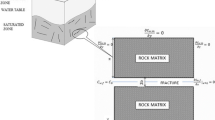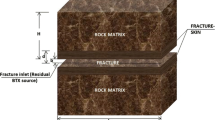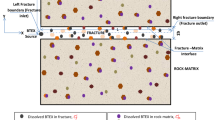Abstract
This paper presents a numerical model to investigate the migration of BTEX (benzene, toluene, ethylbenzene, and xylene) within a fractured aquifer system at the scale of a single fracture under the coupled effect of various transport processes such as dissolution, sorption, biodegradation. The developed model also considers the influence of equilibrium- and kinetic-controlled sorption scenarios on BTEX transport. Further, the transport characteristics of dissolved BTEX within the fracture–matrix system (FMS) are obtained by carrying out the spatial moment analysis on the concentration profiles simulated. In this study, the spatial moment analysis is conducted to estimate the following transport characteristics of dissolved BTEX: (a) velocity within the fracture, (b) dispersion coefficient within the fracture, (c) dissolved mass within the matrix. In order to investigate the sensitivity of various input parameters, two sensitivity indices are computed based on the variation in the velocity of dissolved BTEX constituent within the fracture (SI_vel) and on the variation in the dissolved mass of BTEX constituents within the matrix (SI_mat). Results from the present simulation study suggest that the sorption and biodegradation reactions influence the concentration distribution of highly soluble BTEX constituents (benzene, toluene) within the FMS significantly. The influence of biodegradation on the migration of BTEX within the FMS is found to be more when it co-occurs with the sorption reaction. The effect of sorption and biodegradation reactions on the mobility and dispersion coefficient of dissolved BTEX constituents within the FMS is found to be significant during the early simulation period.












Similar content being viewed by others
References
Arnon, A., Adar, E., Ronen, Z., Yakirevich, A., Nativ, R.: Impact of microbial activity on the hydraulic properties of fractured chalk. J. Contam. Hydrol. 76, 315–336 (2005)
Atteia, O., Guillot, C.: Factors controlling BTEX and chlorinated solvents plume length under natural attenuation conditions. J. Contam. Hydrol. 90, 81–104 (2007)
Bear, J., Tsang, C.F., De Marsily, G.: Flow and Contaminant Transport in Fractured Rock. Academic Press Inc., San Diego (2012)
Bekins, B.A., Cozzarelli, I.M., Cozzarelli, I.M., Godsy, E.M., Warren, E., Essaid, H.I., Tuccillo, M.E.: Progression of natural attenuation processes at a crude oil spill site: II. Controls on spatial distribution of microbial populations. J. Contam. Hydrol. 3–4, 387–406 (2001a)
Bekins, B.A., Rittmann, B.E., MacDonald, J.A.: Natural attenuation strategy for groundwater cleanup focuses on demonstrating cause and effect. EOS Trans. AGU 53, 57–58 (2001b)
Berkowitz, B., Zhou, J.: Reactive solute transport in a single fracture. Water Resour. Res. 4, 901–913 (1996)
Bodin, J., Delay, F., de Marsily, G.: Solute transport in fissured aquifers: 1. Fundamental mechanisms. Hydrogeol. J. 11, 418–433 (2003a)
Bodin, J., Delay, F., de Marsily, G.: Solute transport in a single fracture with negligible matrix permeability: 2. Mathematical formalism. Hydrogeol. J. 11, 434–454 (2003b)
Bradley, P.M., Journey, C.A., Kirshtein, J.D.: Enhanced dichloroethene biodegradation in fractured rock under biostimulated and bioaugmented conditions. Remed. J. 2, 21–32 (2012)
Chambon, J.C., Broholm, M.M., Binning, P.J., Bjerg, P.L.: Modeling multi-component transport and enhanced anaerobic dechlorination processes in a single fracture–clay matrix system. J. Contam. Hydrol. 112, 77–90 (2010)
Chapelle, F.H., Widdowson, M.A., Brauner, J.S., Mendez, E., Casey, C.C.: Methodology for Estimating Times of Remediation Associated with Monitored Natural Attenuation. United States Geological Survey Water Resources Investigations Report. 03-4057 (2003)
Cherubini, C., Pastore, N., Giasi, C.I., Allegretti, N.M.: Laboratory experimental investigation of heat transport in fractured media. Nonlinear Process. Geophys. 24, 23–42 (2017)
Declercq, I., Cappuyns, V., Duclos, Y.: Monitored natural attenuation (MNA) of contaminated soils: state of the art in Europe—a critical evaluation. Sci. Total Environ. 1, 393–405 (2012)
Detwiler, R.L., Rajaram, H., Glass, R.J.: Nonaqueous-phase-liquid dissolution in variable-aperture fractures: development of a depth-averaged computational model with comparison to a physical experiment. Water Resour. Res. 37(12), 3115–3129 (2001)
Detwiler, R.L., Rajaram, H., Glass, R.J.: Interphase mass transfer in variable aperture fractures: controlling parameters and proposed constitutive relationships. Water Resour. Res. 45, W08436 (2009)
Dickson, S.E., Thomson, N.R.: Dissolution of entrapped DNAPLs in variable aperture fractures: experimental data and empirical model. Environ. Sci. Technol. 37(18), 4128–4137 (2003)
Essaid, H.I., Cozzarelli, M.I., Eganhouse, P.R., Herkelrath, W.N., Belkins, B.A., Delin, G.N.: Inverse Modeling of BTEX dissolution and biodegradation at the Bemidgi, M-N crude-oil spill site. J. Contam. Hydrol. 67, 269–299 (2003)
Faybishenko, B., Witherspoon, P., Bodvarsson, G.: Emerging issues in fractured-rock flow and transport investigations: introduction and overview. Dyn Fluids Transp Fract Rocks 162, 1–11 (2005)
Geller, G.T., Holman, H.Y., Su, G., Conrad, M.E., Pruess, K., Hunter-Cevera, J.C.: Flow dynamics and potential for biodegradation of organic contaminants in fractured rock vadose zones. J. Contam. Hydrol. 1, 63–90 (2000)
Goltz, M.N., Roberts, P.V.: Using the method of moments to analyze three-dimensional diffusion-limited solute transport from temporal and spatial perspectives. Water Resour. Res. 23(8), 1575–1585 (1987)
Grisak, G.E., Pickens, J.F., Cherry, J.A.: Solute transport through fractured media 2. The column study of fractured till. Water Resour. Res. 4, 731–739 (1980)
Hansen, S.K., Kueper, B.H.: A new model for coupled multicomponent NAPL dissolution and aqueous-phase transport, with application to creosote dissolution in discrete fractures. Water Resour. Res. 50, 58–70 (2014)
Hardisty, P.E., Wheater, H., Johnston, P.M., Dabrowski, T.L.: Mobility of LNAPL in fractured sedimentary rocks: implications for remediation. In: Proceedings API/NGWA Conference on Hydrocarbons and Organic Chemicals in Groundwater, Houston (1994)
Hölttä, P., Hakanen, M., Hautojärvi, A., Timonen, J., Väätäinen, K.: The effects of matrix diffusion on radionuclide migration in rock column experiments. J. Contam. Hydrol. 21, 1–4 (1996)
Jacobson, G.: Pollution of a fractured rock aquifer by petrol a case study. BMR J. Aust. Geol. Geophys. 8, 313–322 (1983)
Jørgensen, P.R., Helstrup, T., Urup, J., Seifert, D.: Modeling of non-reactive solute transport in fractured clayey till during variable flow rate and time. J. Contam. Hydrol. 68(3–4), 193–216 (2004)
Joshi, N., Ojha, C.S.P., Sharma, P.K.: A nonequilibrium model for reactive contaminant transport through fractured porous media: model development and semi analytical solution. Water Resour. Res. 48, W10511 (2012)
Joshi, N., Ojha, C.S.P., Sharma, P.K., Madramootoo, C.A.: Application of nonequilibrium fracture matrix model in simulating reactive contaminant transport through fractured porous media. Water Resour. Res. 51, 390–408 (2015)
Kischinhevsky, M., Paes-leme, P.J.: Modelling and numerical simulations of contaminant transport in naturally fractured porous media. Transp. Porous Med. 26, 25 (1997)
Knorr, B., Maloszewski, P., Krämer, F., Stumpp, C.: Diffusive mass exchange of non-reactive substances in dual-porosity porous systems—a column experiment under saturated conditions. Hydrol. Process. 30(6), 914–926 (2016)
Kolditz, O.: Modelling flow and heat transfer in fractured rocks: dimensional effect of matrix heat diffusion. Geothermics 24(3), 421–437 (1995)
Krooss, B.M., Leythaeuser, D.: Experimental measurements of the diffusion parameters of light hydrocarbons in water-saturated sedimentary rocks—ll. Results Geochem. Signif. Org. Geochem. 2, 91–108 (1988)
Lu, G., Clement, P.T., Zheng, C., Wiedemeier, H.T.: Natural attenuation of BTEX compounds: model development and field-scale applications. Ground Water 37, 707–717 (1999)
Lundegard, P.D., Johnson, P.C.: Source zone natural attenuation at petroleum hydrocarbon spill sites—II: application to a former oil field. Groundw Monit Remed. 4, 93–106 (2006)
Maloszewski, P., Zuber, A.: Mathematical modeling of tracer behavior in short-term experiments in fissured rocks. Water Resour. Res. 7, 1517–1528 (1990)
Molson, J.W., Frind, E.O., van Stempvoort, D.R., Lesage, S.: Humic acid-enhanced remediation of an emplaced diesel source in groundwater 2: numerical model development and application. J. Contam. Hydrol. 54, 277–305 (2002)
Mulligan, C.N., Yong, R.N.: Natural attenuation of contaminated soils. Environ. Int. 4, 587–601 (2004)
Mutch, R.D., Scott, J.I., Wilson, D.J.: Cleanup of fractured rock aquifers: implications of matrix diffusion. Environ. Monit. Assess. 24, 45 (1993)
Natarajan, N., Suresh Kumar, G.: Numerical modeling and spatial moment analysis of thermal fronts in a coupled fracture-skin-matrix system. Geotech. Geolog. Eng. 29(4), 477–491 (2011)
Neretnieks, I.: Diffusion in the rock matrix: an important factor in radionuclide retardation? J. Geophys. Res. 85, 4379–4397 (1980)
Neretnieks, I., Eriksen, T., Tahtimen, P.: Tracer movement in a single fissure in granite rock: some experimental results and their interpretation. Water Resour. Res. 4, 849–858 (1982)
Ordencrantz, J.E., Valocchi, A.J., Rittman, B.E.: Modeling the interaction of sorption and biodegrdation on transport in groundwater in situ bioremediation systems; In: Proceedings of the Groundwater Modeling Conference, Golden Colorado (1993)
Prommer, H., Barry, D.A., Davis, G.B.: A one-dimensional reactive multi component transport model for biodegradation of petroleum hydrocarbons. Environ. Modell. Softw. 14, 213–223 (1999)
Renu, V., Suresh Kumar, G.: Numerical modeling and spatial moment analysis of solute mobility and spreading in a coupled fracture-skin-matrix system. Geotech. Geolog. Eng. 30, 1289–1302 (2012)
Renu, V., Suresh Kumar, G.: Numerical modeling on benzene dissolution into groundwater and transport of dissolved benzene in a saturated fracture–matrix system. Environ. Process. 3(4), 781–802 (2016)
Renu, V., Suresh Kumar, G.: Benzene dissolution and transport in a saturated sinusoidal fracture with non-uniform flow: numerical investigation and sensitivity analysis. Environ. Process. 4(3), 587–601 (2017a)
Renu, V., Suresh Kumar, G.: Multi-component transport of BTX in a discretely fractured aquifer with fracture–skin: numerical investigation and sensitivity analysis. Environ. Earth Sci. 76, 619 (2017b)
Sekhar, M., Suresh Kumar, G.: Modeling transport of linearly sorbing solutes in a single fracture: asymptotic behavior of solute velocity and dispersivity. Geotech. Geol. Eng. 24(1), 183–201 (2006)
Scow, K.M., Hicks, K.A.: Natural attenuation and enhanced bioremediation of organic contaminants in groundwater. Curr. Opin. Biotech. 3, 246–253 (2005)
Sharma, P., Sekhar, M., Srivastava, R., Ojha, C.: Temporal moments for reactive transport through fractured impermeable/permeable formations. J. Hydrol. Eng. 12, 1302–1314 (2012)
Suresh Kumar, G.: Mathematical modeling of groundwater flow and solute transport in saturated fractured rock using a dual-porosity approach. J. Hydrol. Eng. 19(12), 04014033 (2014a)
Suresh Kumar, G.: Mathematical modelling on transport of petroleum hydrocarbons in saturated fractured rocks. Sadhana 39(5), 1119–1139 (2014b)
Tang, D.H., Frind, E.O., Sudicky, E.A.: Contaminant transport in fractured porous media: analytical solutions for a single fracture. Water Resour. Res. 17, 555–564 (1981)
Tsang, C., Neretneiks, I.: Flow channeling in heterogeneous fractured rocks. Rev. Geophys. 36, 275–298 (1998)
U.S.EPA: A citizen’s guide to natural attenuation. EPA 542-F-96-015. http://www.epa.gov/swertio1/download/remed/citguide/natural.html (1996)
Veettil, R.T., Suresh Kumar, G.: Numerical modeling on the sensitivity of directional dependent interface heat transfer on thermal transport in a coupled fracture–matrix system. Geosci. J. 20(5), 639–647 (2016)
Wu, Y., Ye, M., Sudicky, E.A.: Fracture-flow-enhanced matrix diffusion in solute transport through fractured porous media. Transp. Porous Med. 81, 21–34 (2009)
Yang, Z., Niemi, A., Fagerlund, F., Illangasekare, T., Detwiler, R.L.: Dissolution of dense non-aqueous phase liquids in vertical fractures: effect of finger residuals and dead-end pools. J. Contam. Hydrol. 149, 88–99 (2013)
Zou, L., Jing, L., Cvetkovic, V.: Modeling of solute transport in a 3d rough-walled fracture–matrix system. Transp. Porous Med. 116, 1005–1029 (2017)
Author information
Authors and Affiliations
Corresponding author
Electronic Supplementary Material
Below is the link to the electronic supplementary material.
Rights and permissions
About this article
Cite this article
Valsala, R., Govindarajan, S.K. Mathematical Modeling on Mobility and Spreading of BTEX in a Discretely Fractured Aquifer System Under the Coupled Effect of Dissolution, Sorption, and Biodegradation. Transp Porous Med 123, 421–452 (2018). https://doi.org/10.1007/s11242-018-1049-7
Received:
Accepted:
Published:
Issue Date:
DOI: https://doi.org/10.1007/s11242-018-1049-7




